Enterprise IT is undergoing a “cloud reset”. Organizations are repatriating workloads from public clouds back into their own data centers, driven by escalating security risks, the demand for tighter operational control, predictable costs, and the unique performance requirements of AI.
Born within hyperscale environments, Software for Open Networking in the Cloud (SONiC) is an open‑source network operating system that delivers the agility, efficiency, and transparency modern private infrastructures require. Having proven itself in some of the most demanding deployments, SONiC has matured into a rock‑solid choice for enterprise data centers.
In this article, we’ll explore SONiC’s technical foundation, demonstrate why it now meets and often exceeds enterprise requirements, and outline why investing in SONiC makes strategic sense for any organization ready to own its network stack.
Inside SONiC: Architecture, Stability, and Feature Maturity
The enhanced stability and feature maturity of SONiC are rooted in its underlying technical architecture and the continuous improvements implemented by the active community. Its modular design allows for independent updates and restarts of services, minimizing the impact of potential issues and leading to a more resilient system.
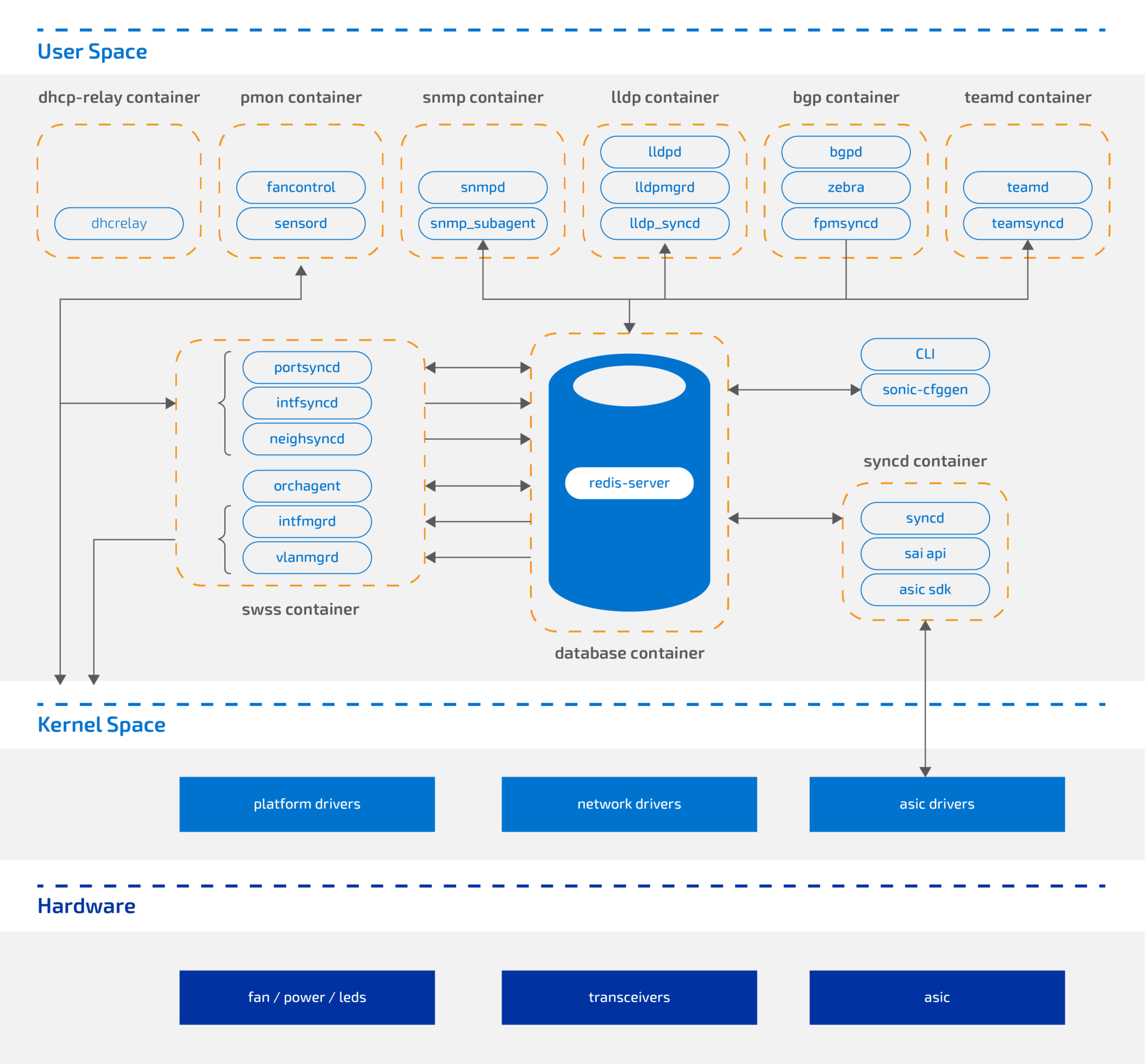
SONiC’s Architecture
Features like in-service upgrades further contribute to enterprise-grade reliability by allowing software updates to be performed without interrupting network traffic. The integration of advanced telemetry and monitoring capabilities provides network operators with comprehensive visibility into the network’s health and performance, enabling proactive identification and faster resolution of emerging problems. For example, real‑time metrics on interface error rates and CRC failures allow you to detect and replace failing ports before packets are dropped; or CPU/memory utilization alerts flag runaway processes or memory leaks, enabling restarting or patching services before they impact forwarding.
Download our white paper to learn more about SONiC's capabilities and unlock its potential for your business. Discover how SONiC can revolutionize your network infrastructure, offering unparalleled flexibility, scalability, and cost optimization.
Moreover, SONiC’s feature set has expanded significantly over time, driven by community contributions that have led to rapid release cycles. It now includes support for key enterprise protocols such as EVPN, MC-LAG, a wide range of advanced routing protocols, and is expanding into new deployment models like modular chassis designs, complementing its established use in T1/TOR configurations.
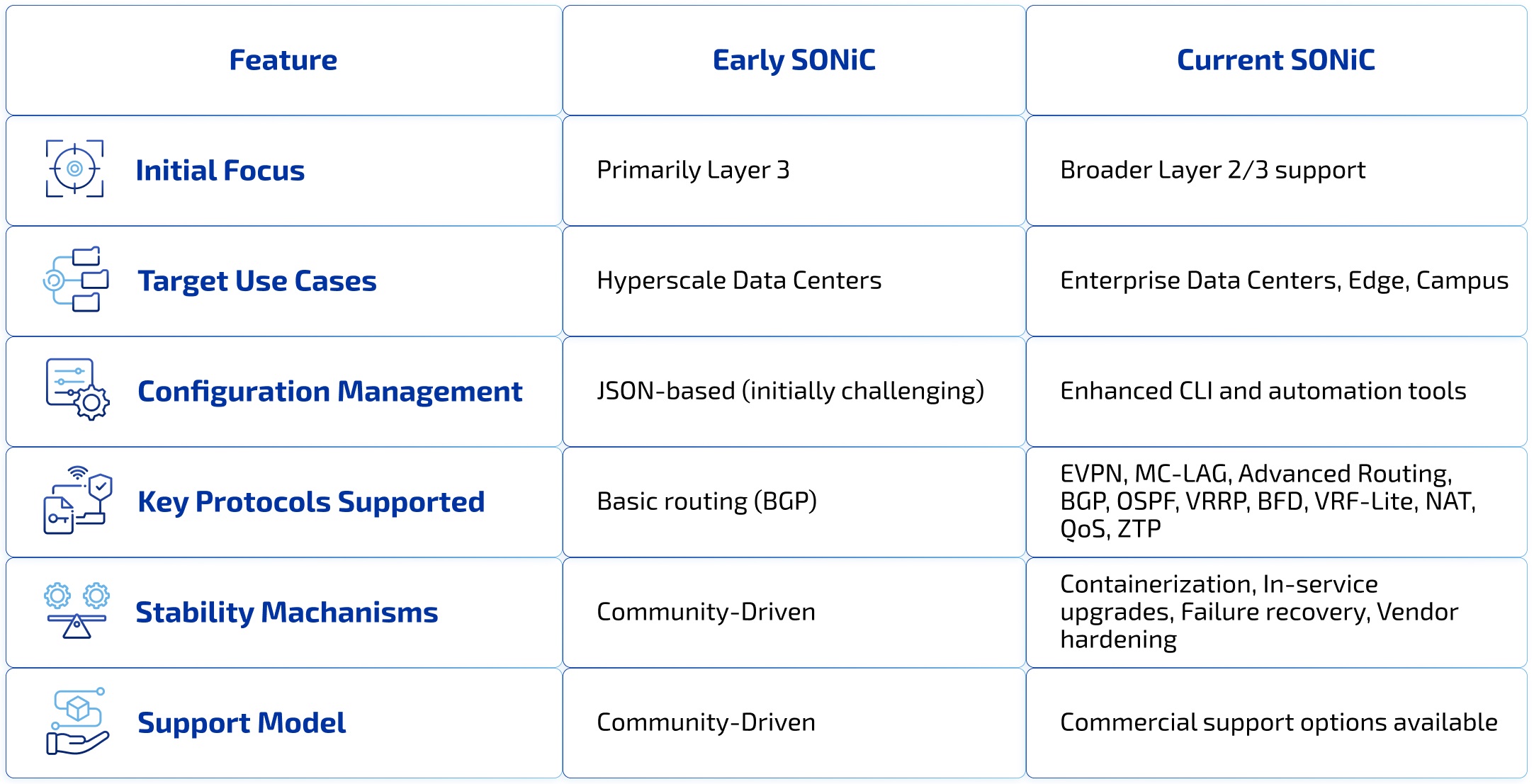
SONiC NOS Feature Comparison: Early vs. Current Versions
SONiC’s open-source nature also enhances security through transparency and community-driven scrutiny. Every feature undergoes a rigorous pull request review process on GitHub to meet strict security standards, with additional security measures contributed by hardware vendors, creating a robust platform.
Having seen how SONiC’s technical foundations deliver rock‑solid stability and rapid feature velocity, let’s look at how this translates into real market momentum.
SONiC’s Enterprise Adoption and Growth Forecast
SONiC’s footprint is expanding rapidly. Gartner estimates that today fewer than 5% of the world’s 100,000+ data centers run SONiC in production – roughly 100–200 large‑scale enterprise deployments, but that share is poised to rise sharply as organizations chase lower TCO and greater agility.
Industry analysts predict SONiC‑based data‑center switching revenues will exceed $5 billion by 2026 and $8 billion by 2027, driven by growing uptake outside hyperscalers. At that pace, the SONiC market could top $15 billion by 2030, implying a compound annual growth rate north of 25%.
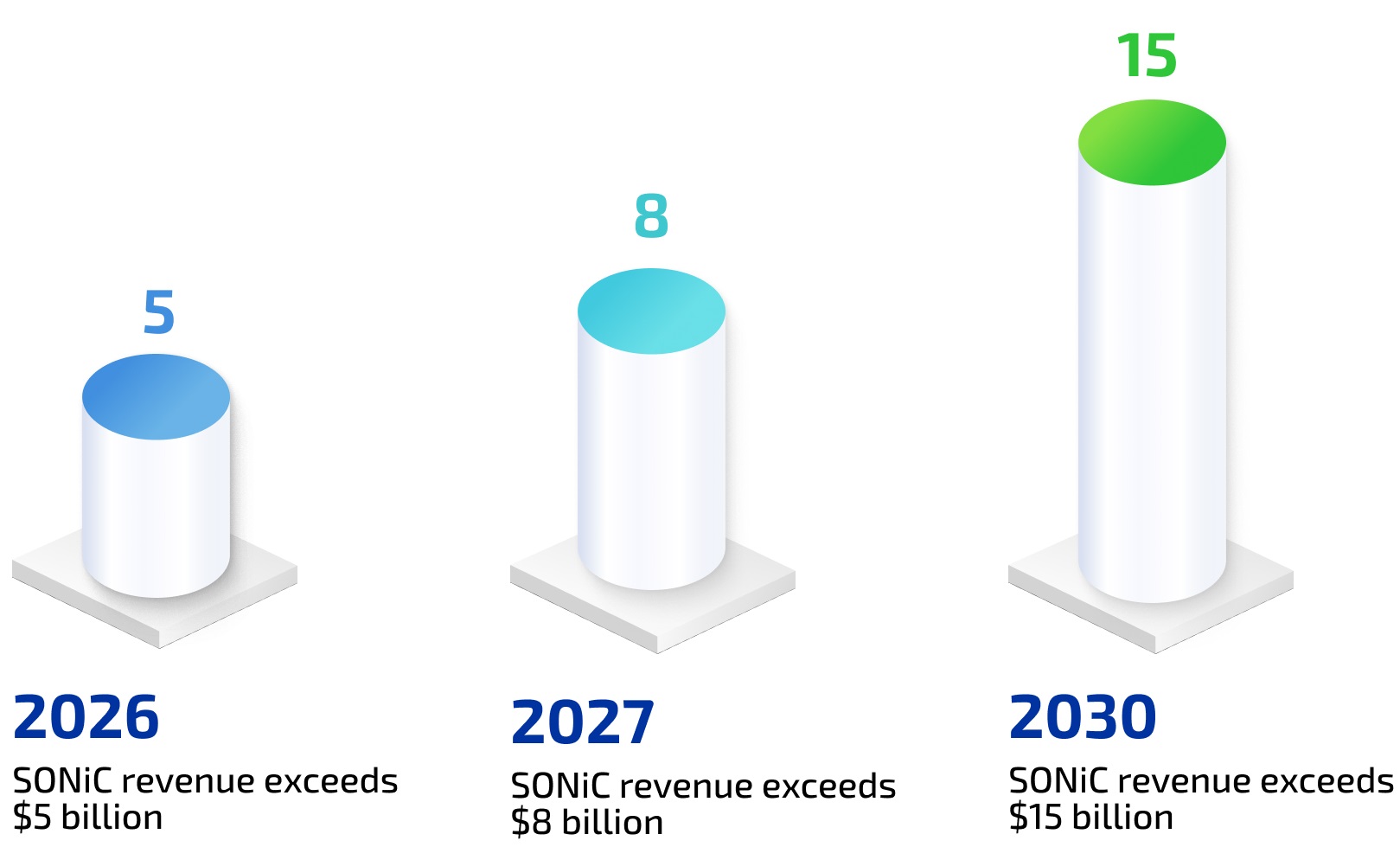
Projected SONiC Market Growth
Real‑world benchmarks further validate SONiC’s versatility: full Layer 2/3 support, high‑performance AI fabrics, and PoE‑capable whitebox switches have all passed industry tests with flying colors. From hyperscale data‑center backbones to branch‑office edges, Community SONiC has earned the trust of healthcare providers, retailers, financial institutions, and beyond.
Major enterprises, including LinkedIn, eBay, Tencent, and Verizon, already run critical network operations on SONiC‑powered switches, and operators such as Orange are deploying hundreds more. What once demanded hyperscaler‑level coding expertise is now plug‑and‑play.
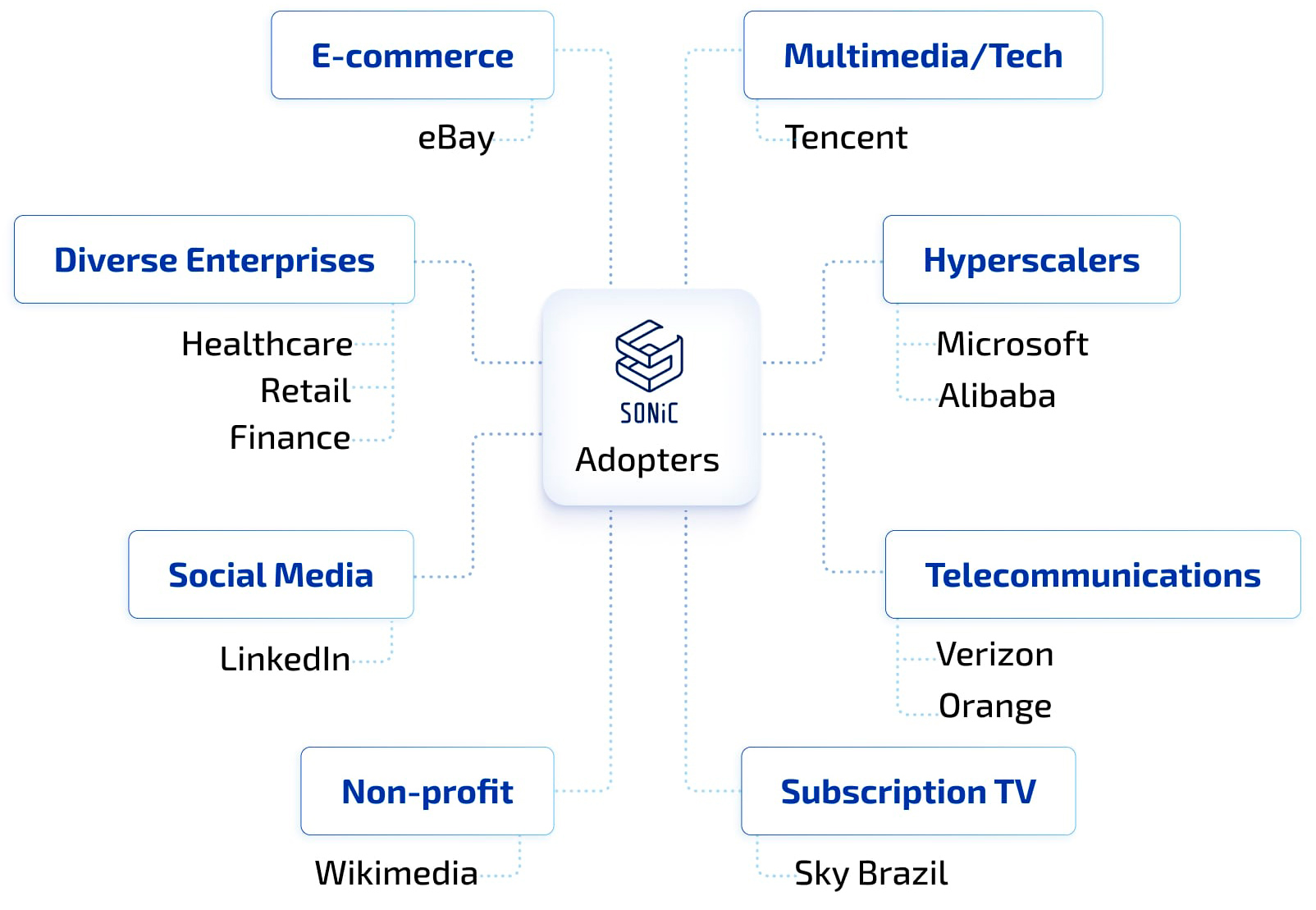
SONiC Adopters: Key Use Cases
This evolution from niche hyperscaler tool to mainstream enterprise solution represents the true democratization of cloud‑scale networking: any organization, regardless of size, can harness the same scalable, cost‑efficient stack that powers the world’s biggest clouds without vendor lock‑in or an army of engineers.
With this rapid adoption and proven track record in place, organizations are increasingly turning to SONiC as the cornerstone of their own private‑cloud and edge strategies.
SONiC and the Trend Toward Private Data Centers
Enterprises today are reexamining their cloud strategies for three key reasons.
- Security, control, and compliance have become non‑negotiable. API‑based attacks and evolving regulations are prompting IT leaders to consider collocation or on‑premises deployments, where teams can customize defenses and safeguard sensitive data, critical for advanced analytics and GenAI workloads.
- Unpredictable cloud bills have many organizations hunting for cost savings. By migrating workloads back on‑premises, companies have recovered millions in wasted spend; private data centers deliver stable pricing, and SONiC’s open‑network model can optimize total cost of ownership.
- The growing demands of AI both for data protection during training and for performance during inference are driving investment in AI‑optimized private clouds. SONiC’s GPU‑ready architecture delivers sub‑microsecond latency over RoCE fabrics, ensuring that your infrastructure is primed for tomorrow’s traffic volumes.
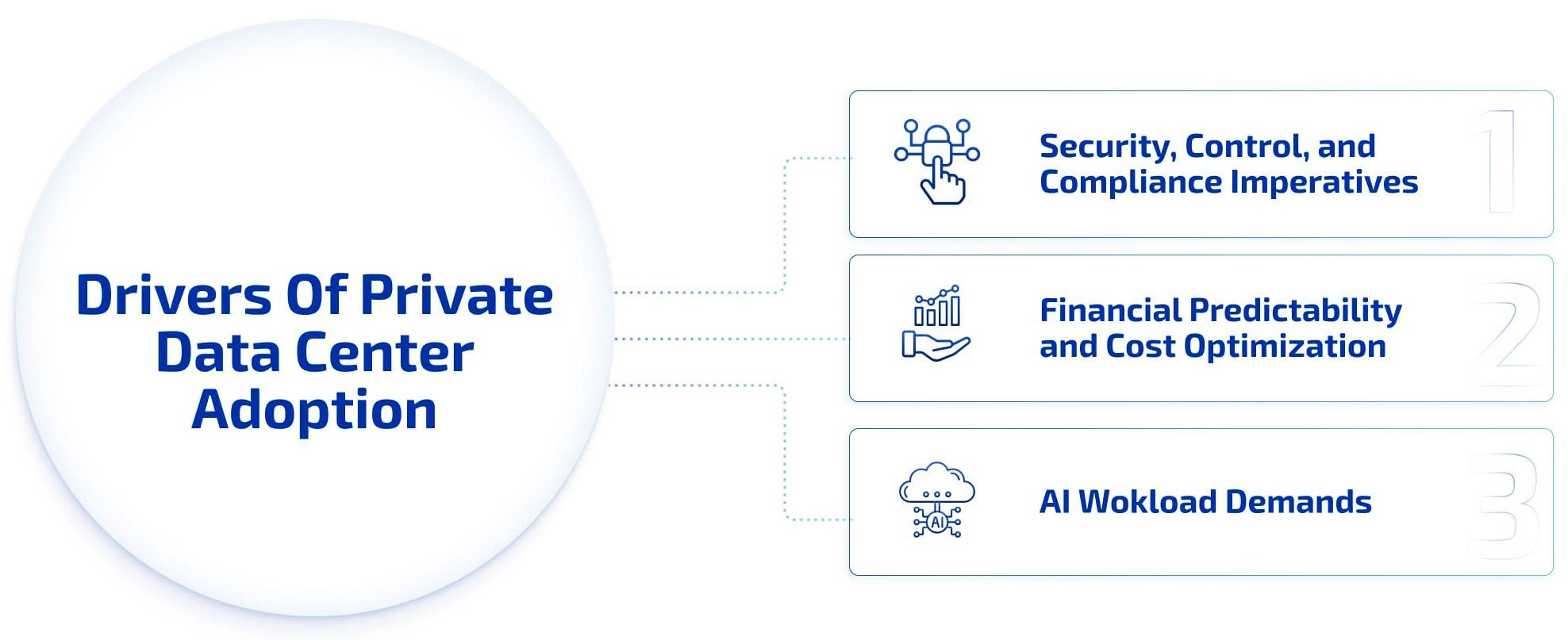
Drivers of Private Data Center Adoption
At the same time, organizations with unique performance profiles or specialized compliance needs can leverage custom SONiC distributions, tailoring only the required features, protocols (e.g., multi‑tenant BGP/EVPN, VXLAN), and hardware integrations, while receiving long‑term support, timely security patches, and vendor‑neutral roadmap alignment that optimizes BOM costs.
Building on that same commitment to flexibility, SONiC Lite addresses the growth in edge computing: it powers lightweight, cost‑sensitive deployments delivering enterprise‑grade networking capabilities at edge scale and without breaking the budget. Key benefits include:
Leverage the white box model
approach and avoid vendor lock-in
Benefit from regular updates
and security patches
Stay ahead of the curve
with ongoing feature development
Get access to custom
NOS features tailored to your
specific use case

SONiC Lite for DC, Edge & Campus
Deployments, and Community SONiC
on Distribution and Core Layers
Optimize OPEX
with less-demanding equipment
and a unified network environment
SONiC Lite Free Demo
Implement SONiC on cost-effective
platforms with SONiC Lite
These trends and capabilities together explain why SONiC is no longer just a hyperscaler’s tool, but a smart, future‑proof choice for any organization building private clouds or edge networks.
Why SONiC is a Smart Investment
SONiC has rapidly become a game‑changer for data center operators. Here are six compelling reasons to consider it:
1. Escape Vendor Lock‑In
Built on an open‑source foundation, SONiC breaks the grip of proprietary NOS vendors. It runs seamlessly on white‑box switches from multiple manufacturers, giving you the freedom to mix and match hardware and silicon.
2. Hardware Disaggregation & Choice
SONiC’s decoupled software‑from‑hardware model means you choose the switch ASIC and form factor that best fit your performance, port‑density, and budget needs.
3. Keep Costs in Check
SONiC’s open‑source model optimizes total cost of ownership (TCO), while its automation and standardization reduce operational overhead. By slashing service and support costs typically associated with closed‑source software, you can manage your network lifecycle with smaller teams. Plus, broad hardware compatibility sparks price competition without sacrificing reliability.
Calculate Total Costs of Ownership: Proprietary vs. Open-Source Based Networks
Download PDF4. Shape the Roadmap
Rather than waiting on a lone vendor’s release schedule, SONiC’s evolution is driven by a vibrant global community. Community initiatives ensure that enterprises have a direct voice in its development and access to certification pathways for new talent.
5. Tailor to Your Needs
SONiC’s modular architecture makes customization straightforward. Whether you need to integrate specialized routing protocols or fine‑tune performance for AI workloads, you can plug in only the components you require. That adaptability makes it ideal for everything from large‑scale data centers to edge and colocation environments.
6. Transparent, Layered Security
With its codebase fully hosted on GitHub, SONiC offers visibility into every line of code. There’s no black box waiting on vendor patches; you can apply fixes and compliance measures on your own schedule.
7. Ready for Tomorrow’s Demands
As AI‑driven networking, edge computing, and intelligent automation reshape IT, SONiC’s cloud‑native design positions you for rapid adoption of emerging technologies. Its active community continually integrates support for next‑gen silicon and AI telemetry, ensuring your network architecture evolves alongside your business.
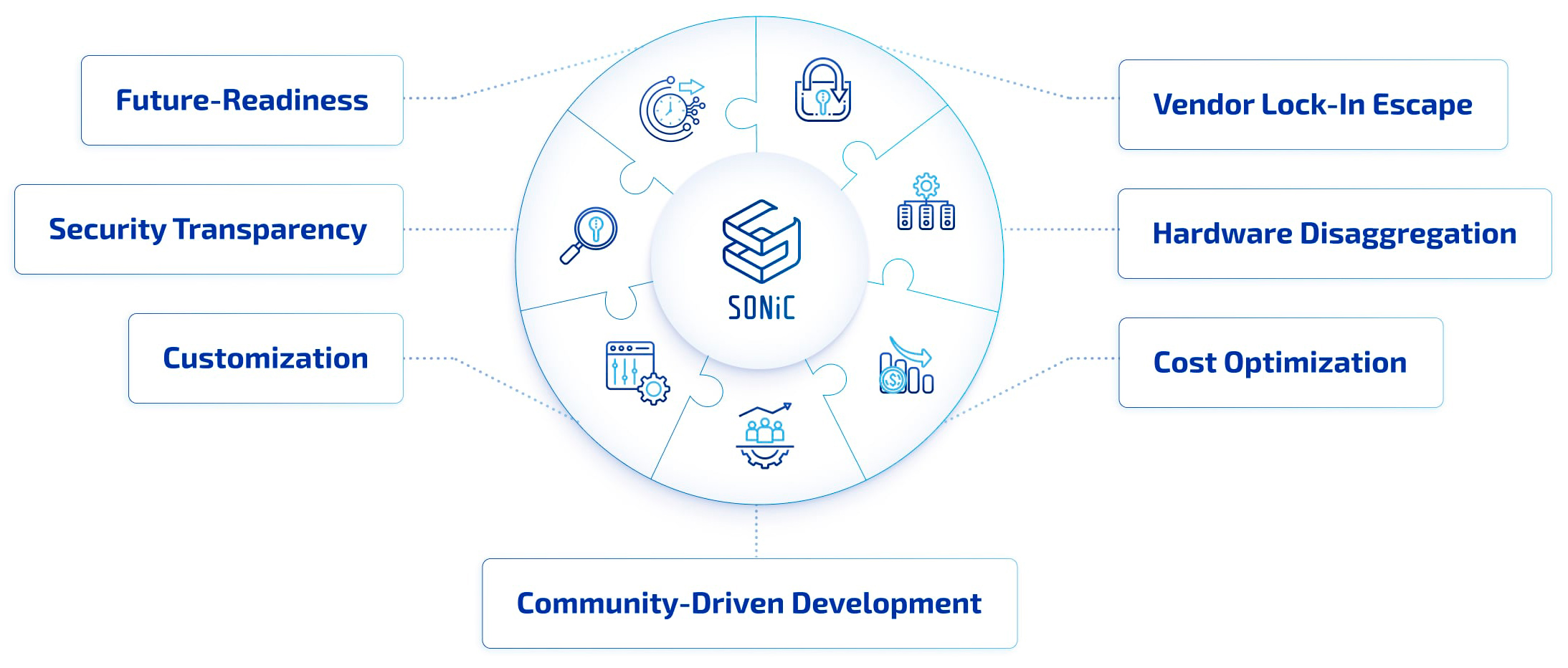
The Strategic Advantages of SONiC
Transitioning to SONiC does require a thorough readiness assessment, especially if you’re moving away from legacy networking gear. However, the long‑term wins in cost savings, operational agility, and strategic control make the initial effort a worthwhile investment.
Conclusion
SONiC NOS has evolved from an innovative idea into a dependable, future‑ready networking solution, especially for enterprise data centers. Its vendor‑agnostic architecture, community‑driven development, and clear cost‑control benefits combine with robust security and proven scalability, making it a standout investment.
As open‑source networking coalesces around SONiC as the emerging standard, demand from service providers, telecom operators, and enterprises will only accelerate. Against the backdrop of today’s shift toward private data centers for greater security and operational control, SONiC isn’t merely an attractive option – it’s fast becoming essential for any modern data center strategy.
Contact Us to Discuss Seamless Implementation
- How AI and Networking Are Rewiring Each Other – and Why Open Networking Matters - October 15, 2025
- PLVision’s SONiC-Based Services: Accelerating Open-Source Network Transformation - September 3, 2025
- SONiC Lite for Edge and Campus: Powering Your Digital Independence - August 18, 2025



